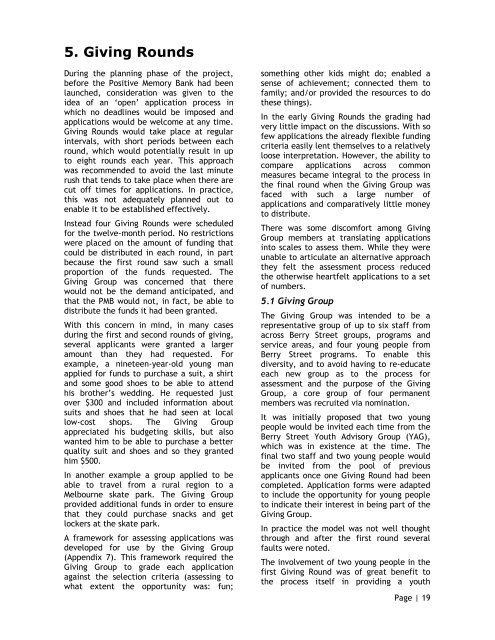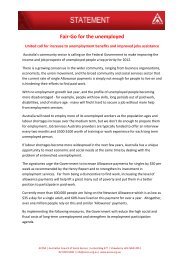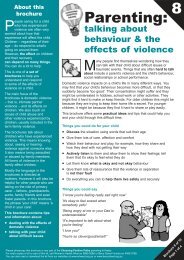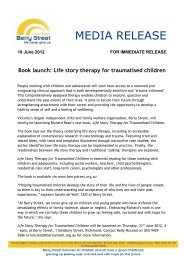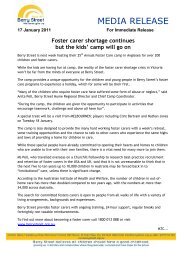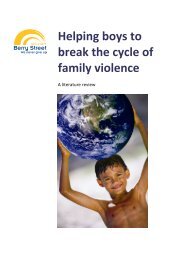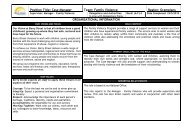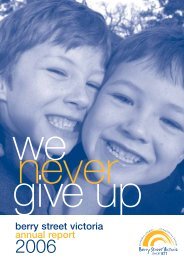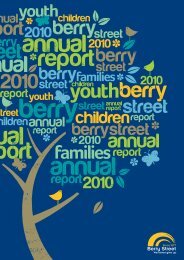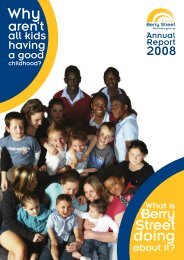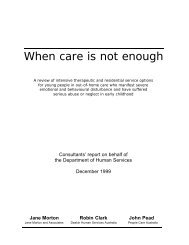Positive Memory Bank - Berry Street
Positive Memory Bank - Berry Street
Positive Memory Bank - Berry Street
Create successful ePaper yourself
Turn your PDF publications into a flip-book with our unique Google optimized e-Paper software.
5. Giving Rounds<br />
During the planning phase of the project,<br />
before the <strong>Positive</strong> <strong>Memory</strong> <strong>Bank</strong> had been<br />
launched, consideration was given to the<br />
idea of an ‘open’ application process in<br />
which no deadlines would be imposed and<br />
applications would be welcome at any time.<br />
Giving Rounds would take place at regular<br />
intervals, with short periods between each<br />
round, which would potentially result in up<br />
to eight rounds each year. This approach<br />
was recommended to avoid the last minute<br />
rush that tends to take place when there are<br />
cut off times for applications. In practice,<br />
this was not adequately planned out to<br />
enable it to be established effectively.<br />
Instead four Giving Rounds were scheduled<br />
for the twelve-month period. No restrictions<br />
were placed on the amount of funding that<br />
could be distributed in each round, in part<br />
because the first round saw such a small<br />
proportion of the funds requested. The<br />
Giving Group was concerned that there<br />
would not be the demand anticipated, and<br />
that the PMB would not, in fact, be able to<br />
distribute the funds it had been granted.<br />
With this concern in mind, in many cases<br />
during the first and second rounds of giving,<br />
several applicants were granted a larger<br />
amount than they had requested. For<br />
example, a nineteen-year-old young man<br />
applied for funds to purchase a suit, a shirt<br />
and some good shoes to be able to attend<br />
his brother’s wedding. He requested just<br />
over $300 and included information about<br />
suits and shoes that he had seen at local<br />
low-cost shops. The Giving Group<br />
appreciated his budgeting skills, but also<br />
wanted him to be able to purchase a better<br />
quality suit and shoes and so they granted<br />
him $500.<br />
In another example a group applied to be<br />
able to travel from a rural region to a<br />
Melbourne skate park. The Giving Group<br />
provided additional funds in order to ensure<br />
that they could purchase snacks and get<br />
lockers at the skate park.<br />
A framework for assessing applications was<br />
developed for use by the Giving Group<br />
(Appendix 7). This framework required the<br />
Giving Group to grade each application<br />
against the selection criteria (assessing to<br />
what extent the opportunity was: fun;<br />
something other kids might do; enabled a<br />
sense of achievement; connected them to<br />
family; and/or provided the resources to do<br />
these things).<br />
In the early Giving Rounds the grading had<br />
very little impact on the discussions. With so<br />
few applications the already flexible funding<br />
criteria easily lent themselves to a relatively<br />
loose interpretation. However, the ability to<br />
compare applications across common<br />
measures became integral to the process in<br />
the final round when the Giving Group was<br />
faced with such a large number of<br />
applications and comparatively little money<br />
to distribute.<br />
There was some discomfort among Giving<br />
Group members at translating applications<br />
into scales to assess them. While they were<br />
unable to articulate an alternative approach<br />
they felt the assessment process reduced<br />
the otherwise heartfelt applications to a set<br />
of numbers.<br />
5.1 Giving Group<br />
The Giving Group was intended to be a<br />
representative group of up to six staff from<br />
across <strong>Berry</strong> <strong>Street</strong> groups, programs and<br />
service areas, and four young people from<br />
<strong>Berry</strong> <strong>Street</strong> programs. To enable this<br />
diversity, and to avoid having to re-educate<br />
each new group as to the process for<br />
assessment and the purpose of the Giving<br />
Group, a core group of four permanent<br />
members was recruited via nomination.<br />
It was initially proposed that two young<br />
people would be invited each time from the<br />
<strong>Berry</strong> <strong>Street</strong> Youth Advisory Group (YAG),<br />
which was in existence at the time. The<br />
final two staff and two young people would<br />
be invited from the pool of previous<br />
applicants once one Giving Round had been<br />
completed. Application forms were adapted<br />
to include the opportunity for young people<br />
to indicate their interest in being part of the<br />
Giving Group.<br />
In practice the model was not well thought<br />
through and after the first round several<br />
faults were noted.<br />
The involvement of two young people in the<br />
first Giving Round was of great benefit to<br />
the process itself in providing a youth<br />
Page | 19


